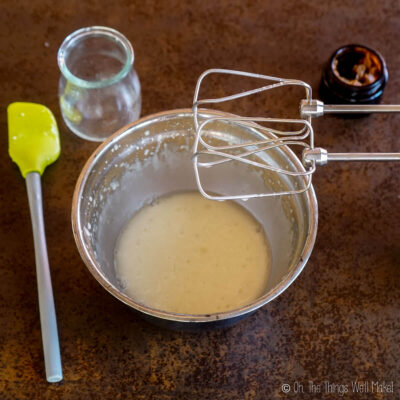

It’s also one of the highest natural sources of CLA (conjugated linoleic acid), especially when made from organic butter and grass-fed cow’s milk. Ghee contains omega 3 and omega 9 essential fatty acids. Ghee is rich in short, medium and long-chain fatty acids, both unsaturated and saturated.Ghee contains vitamins such as A (that has an important role in different metabolic processes, assists in protein absorption and contributes in slowing the ageing process), E (with antioxidant properties), K (that stimulates bone growth/repair and plays a role in blood health).In India, aged ghee is considered to have even more healing properties than the freshly made one (even 100-years old ghee): it’s used externally for therapeutic treatments by Ayurvedic practitioners. Since moisture is largely removed, ghee is shelf-stable: you can store it in the fridge, but it’s safe even if you keep it outside in an airtight container.If ghee is prepared properly, there should be just traces of casein and lactose so it can be suitable even for people who are dairy intolerant, unless a person is extremely sensitive (discuss with your GP if you have any concerns about allergic responses).

Obviously, ghee remains a fat source, so it should be considered in the total daily fat intake, used in limited amounts and appropriately (especially for people who suffer from high cholesterol or related diseases).Ghee as also the ability to give a unique flavour to preparations such as curry, dahl, soups, and it’s useful in baking. 250☌ vs 150☌), so it’s ideal for cooking at high temperature. Typically, ghee has a higher smoke point than butter (approx. 98% of the ghee’s composition are glycerides, while sterols (mostly cholesterol) is usually the 2-5% of total material.
#Milk emulsion butter free#
Chemically, ghee is a complex lipidic mixture made of glycerides, free fatty acids, phospholipids, sterols, sterol esters, fat-soluble vitamins, carbonyls, hydrocarbons, carotenoids (the quantity depends on the milk used), small amounts of casein and traces of minerals such as calcium or phosphorus. The high heat applied to butter removes moisture. Ghee, also known as clarified butter, is obtained by heating the butter with separation of milk solids (casein, lactose): what remains is a golden liquid that will solidify when cool. The Sushruta Samhita, a compendium on medicine and an Ayurvedic classic text, talks about ghee claiming that’s beneficial for the whole body and associates its use as a remedy for issues related to the pitta dosha, such as inflammation.īut what is ghee and how does it differ from butter? Butter is an emulsion, it contains a fat component, water and milk proteins (emulsifiers). The use of ghee for cooking, Ayurvedic treatments, or as part of ceremonies is well-established in the Indian culture (but also in other countries). However, other parameters such as the fat content of the cream and its acidity play a role in generating good butter.Have you ever read about liquid gold? It’s one of the common ways used to talk about ghee, one of the cornerstones of Ayurveda (Indian traditional medicine).

A churn was usually as simple as a barrel with a plunger in it, pushed by hand in Europe from the Middle Ages to the Industrial Revolution. Centrifugation is a technique for separating suspended particles from liquids that involves spinning the mixture at a high speed in centrifuge equipment.Ĭhurning is the process of using a butter churn to agitate cream or whole milk to make butter. Explanation: Churning or centrifugation is the method for separating butter from milk.


 0 kommentar(er)
0 kommentar(er)
